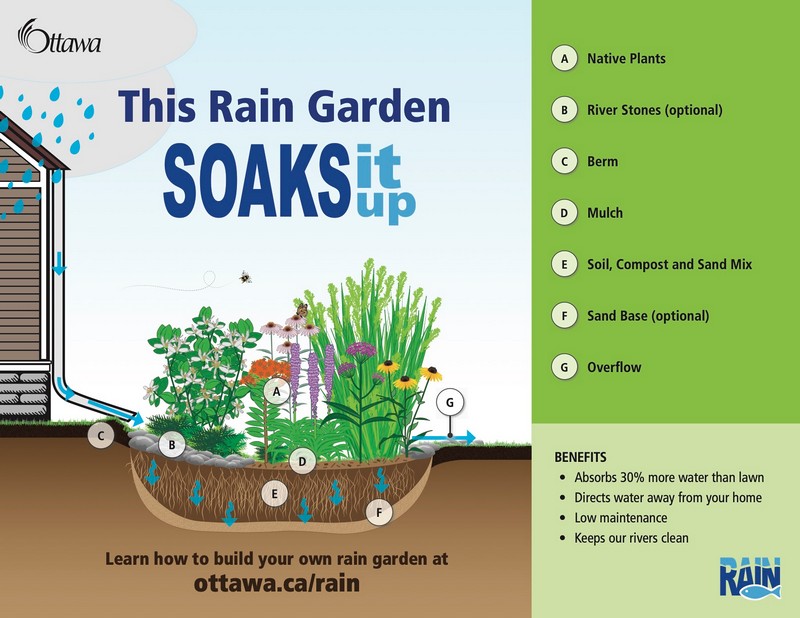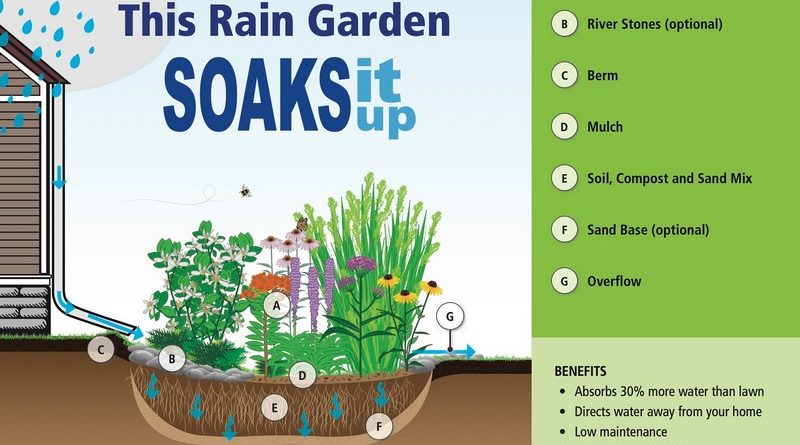Rain Ready Ottawa—keeping rainwater runoff at bay
Bryan Dewalt
Residents of Sandy Hill can now take advantage of Rain Ready Ottawa, a City of Ottawa pilot program to learn how we can manage rainwater runoff on our properties with rain gardens. As a result, we might see the flourishing of more rain gardens in our community.

Photo Brian Ash, English Wikipedia (licensed under Creative Commons)
A rain garden looks much like any other planting of ornamental grasses, flowers, and shrubs. What makes it different is that it is designed to collect runoff from hard impermeable surfaces like roofs, sidewalks, and driveways and hold it long enough for the water to be absorbed into the soil. A rain garden is generally a few inches lower in elevation than surrounding areas and features an inlet such as a downspout for the source water and an outlet for overflow. It is planted with native plants that thrive in the resulting moist conditions.
Managing runoff is an important job for any city. With climate change, major storms are becoming more frequent and more severe. Over the past 15 years, governments have invested hundreds of millions of dollars in Ottawa on major engineering works to mitigate the impact of stormwater on our aging combined sewer system. Through the Rain Ready Ottawa program, the City hopes residents will learn what they can do to reduce the flow at its source.
With densification, stormwater runoff is a growing problem in Sandy Hill. Large building footprints and paved driveways and parking areas shed water quickly. In some cases, redevelopment is also causing local drainage problems, with runoff from newly hardened surfaces pooling in lower-lying neighbouring yards.
This runoff is more than a problem for our foundations and city infrastructure. It is an underappreciated source of water for local plants and trees suffering increasing stress. As a result of many factors, dry periods are becoming longer and deeper. Capturing and holding runoff, so it slowly percolates into the soil, allows plant roots to make use of this moisture for their growth.
Property owners in Sandy Hill can do a number of things to reduce the harmful impacts of rainwater runoff and make better use of this valuable resource. We can redirect downspouts to a permeable surface away from our foundations. We can capture water in a rain barrel. If we have the budget and the appetite for civil engineering, we can install a soak-away pit (i.e., a dry well) or permeable pavement. Perhaps the most pleasing approach, however, is to build a rain garden.
Through its Rain Ready program, the City of Ottawa provides information on how to build a rain garden or take other steps to manage runoff on private property. You can find these resources on the City’s website by searching “Rain Ready Ottawa.” Through the EnviroCentre, the City is also offering residents of Sandy Hill free assessments of rainwater management options on their properties. The number of assessments is limited and available on a first-come first-served basis, so do not wait too long before taking advantage of this opportunity.

Photo City of Ottawa
